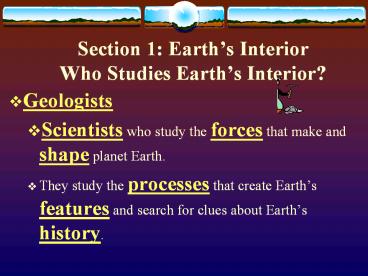Section 1: Earth PowerPoint PPT Presentation
1 / 23
Title: Section 1: Earth
1
Section 1 Earths InteriorWho Studies Earths
Interior?
- Geologists
- Scientists who study the forces that make and
shape planet Earth. - They study the processes that create Earths
features and search for clues about Earths
history.
2
What kind of evidence do scientists use to learn
about the interior of the earth?
- Direct vs. Indirect
- Direct evidence from rock samples. Scientists
drill up to 12 km into the earth. Forces blast
rock from as deep as 100 km. - Indirect evidence from seismic waves
3
How do scientists study the Earth?
- To reach the Earths core you would have to
travel over 6,000 km (3,728 miles)! - Scientists record Seismic Waves a vibration
that travels through Earth carrying the energy
released during an earthquake - Types of seismic waves
- P waves travel through crust (6km/sec) and
mantle (8km/sec) - S waves will not travel through liquid
- http//aspire.cosmic-ray.org/labs/seismic/seismic.
swf
4
What is the Earths structure?
- The Crust
- The Mantle
- Lithosphere
- Asthenosphere
- The Core
- Outer Core
- Inner Core
5
What is the structure of the crust?
- A layer of rock that forms the Earths outer skin
including the rock under the ocean - Two types of crust
- Continental Crust
- Granite less dense crust
- Oceanic Crust
- Basalt more dense rock
6
What is the structure of the mantle?
- Two major parts
- Lithosphere upper part of crust and mantle
together floats on top of the asthenosphere - Asthenosphere softer than the mantle due to
increasing temperature and pressure - The mantle is nearly 3,000 kilometers thick!
(1,864 miles)
7
What is the structure of the core?
- Two parts
- Outer Core liquid behaves like a thick liquid
forces the solid inner core to spin causing
Earths magnetic field - Inner Core solid extreme pressure squeezes the
atoms of iron and nickel so that they cannot
spread out to become liquid - Inner core and outer core are just slightly
smaller than the moon
8
Chemical Layers
Physical Layers
9
Section 2 Convection and the Mantle How does
Heat transfer?
- Radiation heat transfer through empty space
ex. sunlight - Conduction heat transfer through direct contact
- Convection- heat transfer by movement of heated
fluids
10
How do convection currents affect the Earth?
- Heating and cooling a fluid changes its density
warmer fluids have a lower density and float
colder fluids have a higher density and sink
11
Section 3 Drifting ContinentsWere the
continents once together?
- Alfred Wegener hypothesized that all the
continents had moved from a supercontinent known
as Pangaea.
12
What is the evidence for Wegeners idea?
- Evidence of Continental Drift
- Landforms similar mountain ranges
- Fossils similar fossils of a fernlike plant
existed on both continents - Climate tropical pl ant fossils found in cold
climates
13
Section 4 Sea-Floor SpreadingWhat is happening
in the ocean?
- Using sonar scientists discovered mountains under
the ocean - The longest chain of mountains in the world is
under the ocean and is known as the Mid- Ocean
ridge!
14
Side-scan sonar image of the remains of the
submarine USS O-9 (SS-70) off the Isle of Shoals,
New Hampshire in more than 400 feet of
water.Courtesy of NOAA.
Side-scan sonar locates missing planeCourtesy of
NOAA.
15
What is sea-floor spreading?
- Harry Hess suggested that at the mid-ocean ridge
molten material rises from the mantle and erupts
pushing older rock to both sides - This process is known as sea-floor spreading!
16
What is the evidence for Sea-floor spreading?
- Evidence from Molten Material
- Evidence from Magnetic Strips
- Evidence from Drilling Samples
17
How can the ocean floor keep from getting wider
and wider?
- The older ocean floor plunges into deep-ocean
trenches in a process known as subduction - Sea-floor spreading and subduction work together
like a giant conveyer belt!
18
Section 5 What is the theory of plate tectonics?
- The Earths lithosphere is cracked into separate
sections known as plates - Geological theory states that these plates are in
constant, slow motion, driven by the convection
currents in the mantle
19
How is the theory of plate tectonics different
from continental drift?
- Continental drift is based on the movement of the
continents DUE to plate tectonics - Continents are NOT the same as plates
- Tectonic plates can be made up of both oceanic
crust and continental crust
20
What happens where the plates meet?
- Plate Boundaries where the edges of the
lithosphere meet faults form along these
boundaries - Transform
- Divergent
- Convergent
21
What are Transform boundaries?
- The place where two plates slip past each other,
moving in opposite directions - Earthquakes occur frequently at these boundaries
22
What are Divergent Boundaries?
- The place where two plates move apart, or diverge
and create a rift valley - Most occur at the mid-ocean ridge although some
can occur on land
23
What are Convergent boundaries?
- The place where two plates come together, or
converge creating a collision - Subduction occurs at convergent boundaries
- The density of the crust determines which crust
will be on top if both plates are the same
density they form a mountain range

